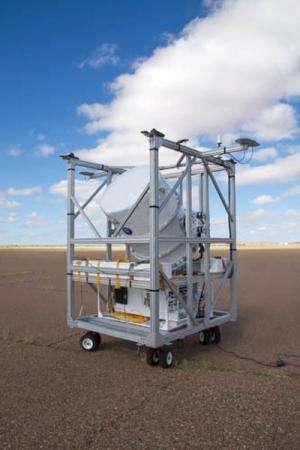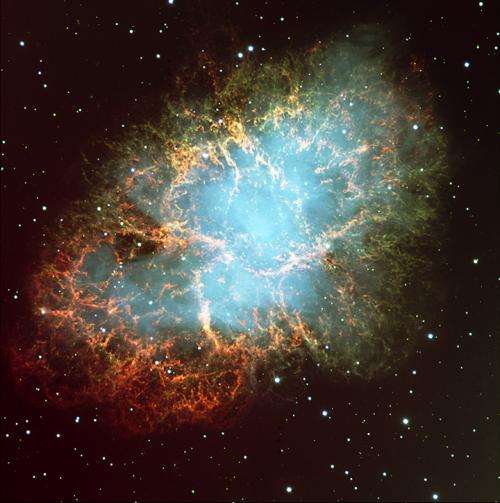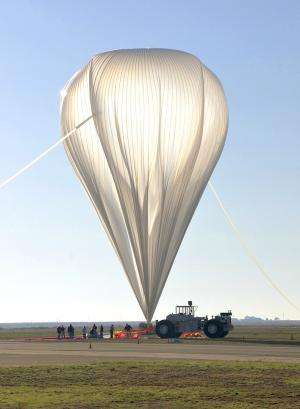Scientific balloon set to measure gamma rays from the Crab Pulsar

Starting today at NASA's Columbia Scientific Balloon Facility in Fort Sumner, New Mexico, space scientists from the University of New Hampshire will attempt to launch a football-field-sized balloon carrying a one-ton instrument payload that will measure gamma rays from the Crab Pulsar - the remains of a 1054 A.D. supernova explosion 6,500 light years from Earth. The measurements, taken 130,000 feet above Earth, could eventually provide a window into the universal, poorly understood process of particle acceleration.
The Gamma Ray Polarimeter Experiment (GRAPE), which was designed and built at the Space Science Center (SSC) within the UNH Institute for the Study of Earth, Oceans, and Space, is an effort to apply a new type of detector technology to the study of celestial gamma rays. The launch is highly dependent on weather and upper atmospheric wind conditions. The launch window closes at the end of this month.
The specific goal of the GRAPE mission is to study the polarization of gamma rays from celestial sources. "Polarized" radiation vibrates in a preferred direction, and the extent of that polarization can provide clues to how the radiation was generated, in essence serving as a probe of the source.
Detecting gamma-ray polarization can provide astrophysicists with a better understanding of particle acceleration, a ubiquitous and important but poorly understood process that occurs throughout the universe - from Earth's magnetic field to pulsars and black holes.
The gamma rays emitted from the Crab Pulsar may be produced from the interactions of a highly accelerated beam of subatomic particles - massive ejections of high-energy particles that are thought to take the form of a narrow jet moving at nearly the speed of light.
"We think that an accelerated beam of particles is the source of the high-energy radiation from the Crab Pulsar, but the structure of that beam and the mechanism by which the radiation is generated is not entirely clear," says mission lead scientist Mark McConnell, a professor in the SSC and chair of the UNH department of physics.

The New Mexico-based flight, the second such proof-of-concept experiment in three years, is not designed to reach the ultimate goal of the project, which is to study gamma-ray bursts - perhaps the most energetic processes in the universe. Achieving that will require a third, follow-up flight over Antarctica where the balloon, due to circumpolar winds that occur between December and January, would circle the pole for 30 to 40 days. The upcoming flight could last as long as 40 hours.
Says McConnell, "To study the gamma-ray burst phenomena we need much more time because they occur randomly in the sky at a rate of about once per day and last at most a couple of minutes. So a long flight will be required to measure a number of bursts."
However, McConnell notes, a second, successful short-duration demonstration flight should provide the best measurements of the polarization of gamma rays emanating from the Crab Pulsar to date because of the sophistication of the instrumentation - the "polarimeter" detectors developed at UNH are capable of making the difficult measurement. A successful flight this year would pave the way for an Antarctic launch as early as 2016.

Large high-altitude balloons have been used to carry NASA experiments to the edge of space for more than 50 years. They provide a vastly cheaper and less time-consuming approach than satellite-based missions and afford an excellent opportunity for graduate and undergraduate student research projects. GRAPE has already produced two Ph.D. theses.
McConnell says that the GRAPE technology is currently being used to develop a NASA proposal for a dedicated satellite mission to study the X-ray and gamma-ray polarization of gamma-ray bursts. Known as PETS (Polarimeters for Energetic Tranisents), the $150 million project would lead to a satellite mission in 2020.
More information: The launch can be viewed via a NASA live feed at: 74.50.147.9/CgiStart?page=Single&Language=0
Real-time GPS data will be available (portrayed on a Google map) for the flight at: towerfts.csbf.nasa.gov



















